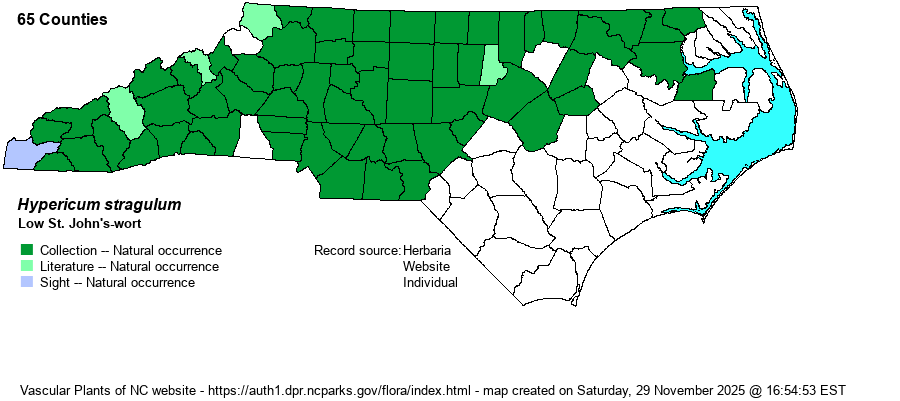| Section 6 » Family Hypericaceae |
Show/Hide Synonym
| taxonName | relationship | relatedTaxonName | relatedTaxonRefText | relComments |
|---|
|
|
|
|
|
|
|
| Hypericum stragulum | = | Ascyrum hypericoides var. multicaule | Fernald (1950) | | | Hypericum stragulum | = | Ascyrum hypericoides var. multicaule | Gleason (1952) | | | Hypericum stragulum | = | Ascyrum hypericoides var. multicaule | Flora of West Virginia | | | Hypericum stragulum | = | Hypericum hypericoides ssp. multicaule | Flora of North America (1993b, 1997, 2000, 2002a, 2002b, 2003a, 2004b, 2005, 2006a, 2006b, 2006c, 2007a, 2009, 2010) | | | Hypericum stragulum | = | Hypericum hypericoides ssp. multicaule | | | | Hypericum stragulum | = | Hypericum hypericoides ssp. multicaule | | | | Hypericum stragulum | = | Hypericum hypericoides ssp. multicaule | Stevens in Kubitzki, Bayer, & Stevens (2007). Key based in part on Adams (1973), Godfrey (1988), C, and GW. {add for FL: Hyperi | | | Hypericum stragulum | = | Ascyrum multicaule | | | | Hypericum stragulum | = | Hypericum stragalum | Radford, Ahles, and Bell (1968) | | | Hypericum stragulum | = | Hypericum stragalum | | | | Source: Weakley's Flora |
|
| Author | W.P. Adams & Robson | |
| Distribution | Found throughout the Piedmont, and over the southern and central Mountains. Also present in the northwestern Coastal Plain, south to Johnston and Washington counties. It appears to be absent in the northern Mountains and the southern two-thirds of the Coastal Plain. Occurrences in the Sandhills are misidentified, immature plants of H. hypericoides.
Widespread over much of the eastern U.S., from MA to KS and south to central GA and central TX. It generally is not found in the Coastal Plains south of northern NC. Note: The BONAP atlas does not have a distribution map for this species, as it follows the taxonomic treatment of this being lumped into H. hypericoides.
| |
| Abundance | Fairly common to common over most of the Piedmont; uncommon to fairly common in the southern half of the Mountains and northern Coastal Plain. Abundance can be somewhat confusing or uncertain, as this taxon is essentially a decumbent “form” of H. hypericoides. | |
| Habitat | This is a species of dry habitats – upland woods, rocky woods, sandy pinelands, roadbanks, woodland borders, and weedy fields. | |
| Phenology | Blooms and fruits from May to August. | |
| Identification | This is a leaning or decumbent deciduous shrub growing only to about 1 foot tall, with a matted appearance. It has multiple stems and thus is much wider than tall. The opposite leaves and flowers are essentially like those of H. hypericoides – narrow and oblanceolate with rounded tips and tapering sessile bases, and four yellow petals in the shape of an X instead of a plus (+). The very similar H. hypericoides has a single stem, grows to 3 feet tall with branches from the upper part of the stem; and it can have somewhat more variably-shaped leaves. The main confusion might be when this latter species is cut by mowing or burned with a fire, and thus the plant would be of very short stature and might have more than one stem. | |
| Taxonomic Comments | Many references lump this species into the more southerly (but overlapping) H. hypericoides, calling it H. hypericoides ssp. multicaule. This is not biologically correct, as these two forms have strongly overlapping ranges and can occur together; subspecies must be allopatric. Also, many older references included the four-petaled species in the genus Ascyrum. Finally, the RAB (1968) manual misspelled the scientific name as “stragalum”; it is “stragulum”.
| |
| Other Common Name(s) | Straggling St. John’s-wort, Multi-stemmed St. John’s-wort, St. Andrew’s Cross (used for the combined two species) | |
| State Rank | S5 | |
| Global Rank | G4 | |
| State Status | | |
| US Status | | |
| USACE-agcp | | |
| USACE-emp | | |

